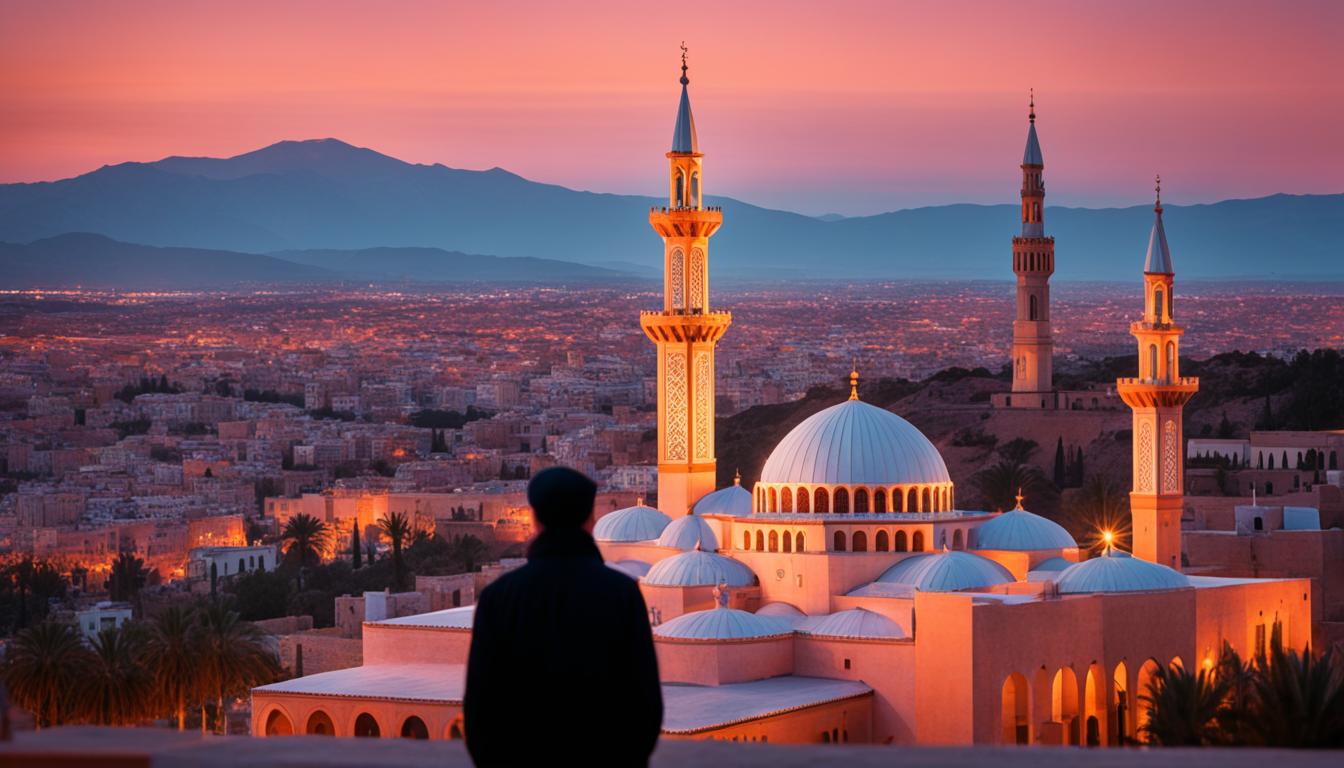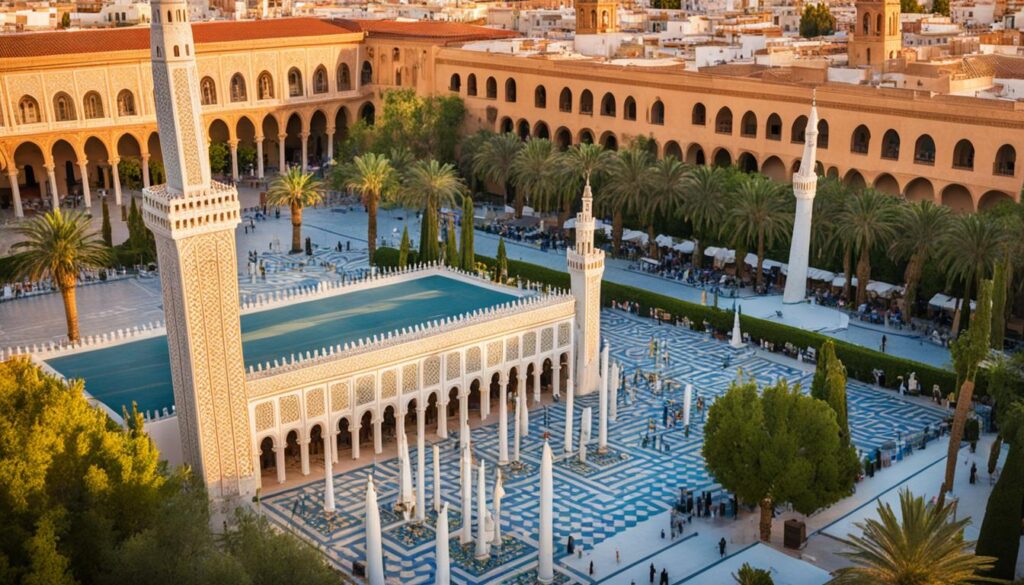
Exploring Spanish Mosques: A Cultural Journey
In Spain, amidst its historic landscape, lies a hidden gem – its rich Islamic heritage. Did you know the Muslim Moors once ruled Spain? They left behind magnificent mosques. Despite efforts to erase this history, several Spanish mosques still stand. They showcase remarkable architecture and cultural significance. Join us on a journey through the Islamic past of Spain. Here, each mosque narrates a chapter of the nation’s diverse cultural heritage.
Islamic Architecture in Spain
Islamic architecture in Spain shows the deep cultural exchange of the Al-Andalus period. Muslim rulers mixed their architectural styles with Roman and Visigothic influences. This blend created something special.
“The Islamic architecture in Spain represents a harmonious blend of different cultures and artistic traditions.” – Architectural historian
This blend led to a unique style seen in mosques, palaces, and fortresses across Spain. One key feature is the horseshoe arches. They are celebrated for their elegance and beauty.
“The intricate geometric designs found in Spanish mosques are a testament to the mathematical genius of Islamic architects.” – Art historian
The style also includes intricate geometric designs and azulejos tilework. These features are key to Islamic artistry.
The Enduring Legacy
The legacy of Islamic architecture is evident in Spain’s iconic buildings. The Alhambra and the Mezquita-Catedral de Córdoba are prime examples. They highlight the culture and creativity of the Al-Andalus era.
“The Alhambra is a masterpiece that showcases the true essence of Islamic architectural design, creating an enchanting atmosphere for visitors.” – Cultural enthusiast
The Alhambra is known for its stucco work, gardens, and courtyards. The Mezquita-Catedral de Córdoba is famous for its horseshoe arches and mihrab. Both are perfect examples of Islamic architecture’s beauty and complexity.
| Architectural Elements | Examples |
|---|---|
| Horseshoe Arches | Mezquita-Catedral de Córdoba |
| Geometric Designs | Alhambra |
| Azulejos | Madrasa of Granada |
Islamic influence in Spain is seen beyond mosques and palaces. Many Spanish houses and buildings feature courtyards, fountains, and tilework. These elements reflect the Moorish tradition.
Islamic architecture in Spain keeps inspiring architects worldwide. Its lasting impact shows the diverse and rich history of Spain.
The Great Mosque of Cordoba: Jewel of Islamic Spain
The Great Mosque of Cordoba is a masterpiece of Islamic art. Built in the 8th century, it combines Islamic, Byzantine, and Visigothic styles. It is known for its horseshoe arches, mosaics, and a vast prayer hall.
Even after becoming a cathedral in the 13th century, it remains historically important. It shows how different faiths can live together. UNESCO recognized its significance as a World Heritage Site.

Visiting this mosque offers insight into Islamic Spain’s rich architecture. As you walk through, the play of light and shadow is mesmerizing. It makes you deeply admire Islamic artistic talent.
“The Great Mosque of Cordoba stands as an architectural marvel, embodying the fusion of cultures that once thrived in this region. Its splendor is a tribute to the ingenuity and creativity of Islamic architects and artisans.”
Exploring the Great Mosque lets you dive into Islamic Spain’s history. It showcases the beauty of Islamic architecture and Spain’s diverse culture. It reminds us of the value of preserving our cultural heritage.
Journeying Through Spain’s Other Prominent Mosques
The Great Mosque of Cordoba is well-known in Spain’s Islamic heritage. But, several other mosques also preserve the country’s cultural and architectural legacy. For example, the Alcazar Mosque in Seville and the Alhambra in Granada invite us on an exciting journey through Islamic Spain.
Each mosque has its own architectural style and shows the multicultural influences of Spain’s Islamic history. The Alcazar Mosque mixes Moorish and Gothic styles. The Alhambra is famous for its detailed Nasrid architecture.
These mosques are more than just places of worship. They are key cultural centers that bring communities together and celebrate Islamic Spain. They help preserve culture and let people dive into the region’s rich history.
Visiting these mosques shows off stunning architecture and helps us understand and value Spain’s cultural diversity. It reminds us that Islamic heritage in Spain goes beyond just one famous building. It’s part of the country’s very essence, covering landscapes and communities.
Take the chance to explore these significant Spanish mosques. Experience the cultural preservation that keeps Islamic Spain’s spirit vibrant.

Impact of Islamic Architecture on Spanish Culture
Islamic architecture has deeply influenced Spanish culture. It has shaped the country’s art, literature, and identity. The blend of Islamic, Moorish, and Christian styles created the unique Mudejar style. This style is seen in landmarks like the Alhambra Palace.
The Mudejar style mixes Islamic decorative art with Christian Gothic architecture. It creates a special architectural language. This mix is seen in the geometric patterns, ornate arches, and colorful tilework in Spain.
The Alhambra Palace in Granada is a famous example. It shows the beauty of Islamic craftsmanship. The palace has stunning stucco work, delicate arabesques, and peaceful courtyards. The play of light and shadow here feels magical.
The Mudejar style in Spanish architecture shows the cultural diversity. It is a sign of peaceful coexistence of different traditions. – Juan Carlos, Art Historian
Islamic architecture’s impact goes beyond buildings. It influences Spanish artistic traditions. We see this in the detailed ceramic work, bright textiles, and decorative arts. These arts are key to Spanish culture.
This mix of Islamic and Spanish elements shapes Spain today. It reminds us of historical cultural and religious interactions. It shows the value of cultural diversity and interfaith dialogue in our world.
The Mudejar Style: A Unique Blend of Cultures
The Mudejar style reflects the peace among Muslims, Christians, and Jews in medieval Spain. It is a peak of cultural exchange and collaboration. This created a rich architectural tradition that goes beyond religions.
The Mudejar style combines Islamic and Christian architectural elements. This blend symbolizes cultural diversity. It shows how Spanish society was adaptable, allowing different cultures to coexist and flourish.
| Islamic Influences | Christian Influences |
|---|---|
| Arches: Horseshoe, Pointed, and Ogee | Arches: Pointed, Round, and Lobed |
| Geometric Patterns | Gothic Ribbed Vaulting |
| Calligraphy | Statues and Iconography |
The Mudejar style shows the achievements of Islamic Spain in architecture and art. It stands for cultural tolerance and acceptance. This style proves how different civilizations can come together to create something extraordinary.
The Significance of Ramadan in Spanish Mosques
Ramadan is very important in Spanish mosques. It brings people together for fasting, prayer, reflection, and charity. Muslims in Spain follow the holy month carefully. They also celebrate their cultural traditions with their religious practices.
During Ramadan, Spanish mosques become places full of spiritual life. Believers gather to improve their faith and connect with others. The feeling of devotion and unity is strong, as everyone aims to get closer to God and each other.
The iftar meal is a key part of Ramadan in Spanish mosques. It happens at sunset to end the fast. Families and communities come together to share this meal. They enjoy traditional dishes and welcome each other warmly. It’s a time of happiness and unity, building stronger community bonds.
In Ramadan, Spanish mosques also offer special prayers and events. They provide spiritual guidance and support for worshippers. This includes Quran recitation, sermons, and chances for people to learn more about Islam.
Ramadan is more than just personal reflection and spiritual growth. It’s also about helping the community. Spanish mosques organize charity work. They distribute food to the poor, support orphanages, and help those in financial need. These actions show the true spirit of compassion and generosity of Ramadan.
A Time for Cultural Celebration
During Ramadan, Spanish Muslims follow their religious duties and enjoy their cultural traditions. This mix shows the rich diversity of Spain’s Islamic history. It’s usual for Spanish Muslims to celebrate Iftar with Spanish dishes and traditional foods from the Middle East and North Africa.
In Ramadan, Spanish mosques turn into lively cultural centers. They have music, art, and traditional performances. These showcase the unique mix of Islamic and Spanish cultures in the country. This celebration lets Spanish Muslims show their dual identities and appreciate their heritage more.
Spanish mosques are key places for bringing people together during Ramadan. They blend religious devotion, cultural celebration, and charity work. Ramadan highlights the importance of Spanish mosques in showing faith, community, and cultural diversity.
| Significance of Ramadan in Spanish Mosques | Key Elements |
|---|---|
| Fasting | Observance of fasting from dawn to sunset. |
| Prayer | Special prayers and gatherings held in mosques. |
| Iftar | Shared meal after sunset to break the fast. |
| Acts of Charity | Organizing charitable activities to support the community. |
| Cultural Celebration | Incorporating Spanish and Islamic traditions during Ramadan. |
Conclusion
Exploring Spanish mosques is more than seeing buildings. It’s a celebration of how cultures come together. These mosques are reminders of a time when Islamic civilization shined in Spain. They show us the rich heritage we can learn from. By honoring this part of Spain’s history, we learn more about its diverse past. This helps in talking and sharing between different cultures.
Going to these mosques means diving into Spain’s fascinating history and architecture. You’ll see the amazing Great Mosque of Cordoba and Alcazar Mosque in Seville, among others. Each one has its own story and beauty. Walking through Spain, the beautiful designs and artworks in these mosques will surely amaze you.
Start planning your trip to Spain now. This journey shows how different cultures and traditions are linked. You’ll see stunning buildings, feel the spiritual peace, and know more about preserving history.
Spanish mosques are alive with stories of cultures coming together. They show us the importance of sharing our histories. By visiting them, we accept our diverse world. We hope for a future with more understanding, respect, and unity.
FAQ
What is the significance of Spanish mosques in terms of cultural heritage?
Spanish mosques are very important as they show the Islamic heritage in Spain. They display beautiful architecture and tell stories of the country’s mix of cultures.
What is the architectural style of Spanish mosques?
The style of Spanish mosques is truly unique. They have elements like horseshoe arches and detailed designs. These designs come from Islamic, Roman, and Visigothic influences.
Which is the most famous mosque in Spain?
The Great Mosque of Cordoba is Spain’s most celebrated mosque. It was built in the 8th century. This mosque is known for its stunning arches, mosaics, and a vast prayer hall.
Are there any other prominent mosques in Spain?
Yes, Spain has many notable mosques. For instance, the Alcazar Mosque in Seville and the Alhambra in Granada. Each has its own style and shows the country’s rich cultural mix.
How has Islamic architecture influenced Spanish culture?
Islamic architecture has deeply influenced Spanish culture. It has shaped art, literature, and the country’s identity. The blend of Islamic, Moorish, and Christian elements created the unique Mudejar style. This style has impacted various artistic expressions.
What is the significance of Ramadan in Spanish mosques?
The holy month of Ramadan is special in Spanish mosques. It is a time for fasting, prayer, reflection, and giving. It brings Spanish Muslims together, honoring their traditions.
Why is it important to explore Spanish mosques?
Exploring Spanish mosques lets us take a cultural journey through Spain’s history and architecture. It deepens our understanding of Spain’s diverse past. It also encourages dialogue and cultural sharing.
Source Links
- https://traveltriangle.com/blog/spanish-mosques/
- https://www.nytimes.com/2022/08/30/travel/spain-travel-moorish-arab.html
- https://www.linkedin.com/pulse/exploring-spains-islamic-heritage-during-ramadan-great-mónica-romero-5vtef

Leave a Reply